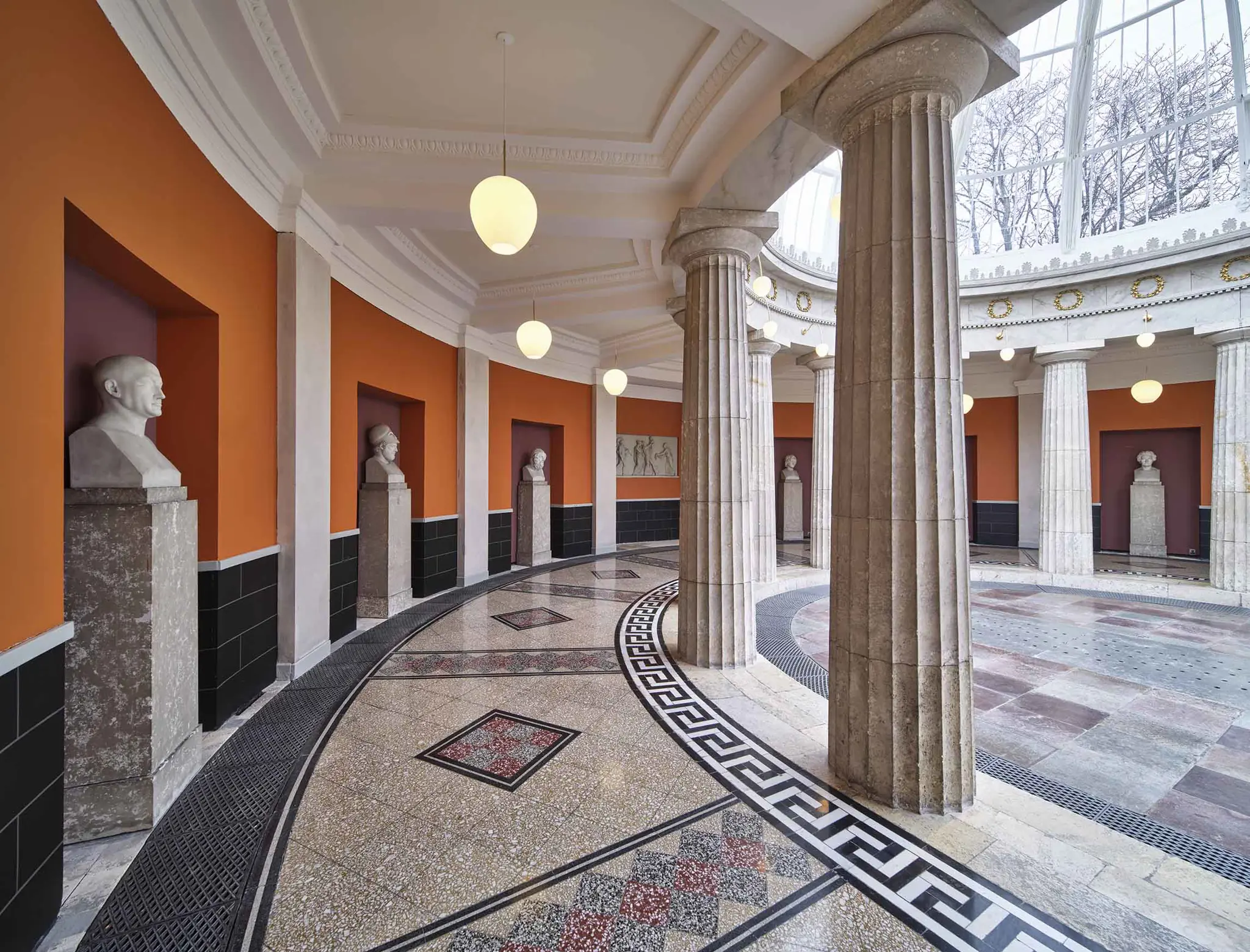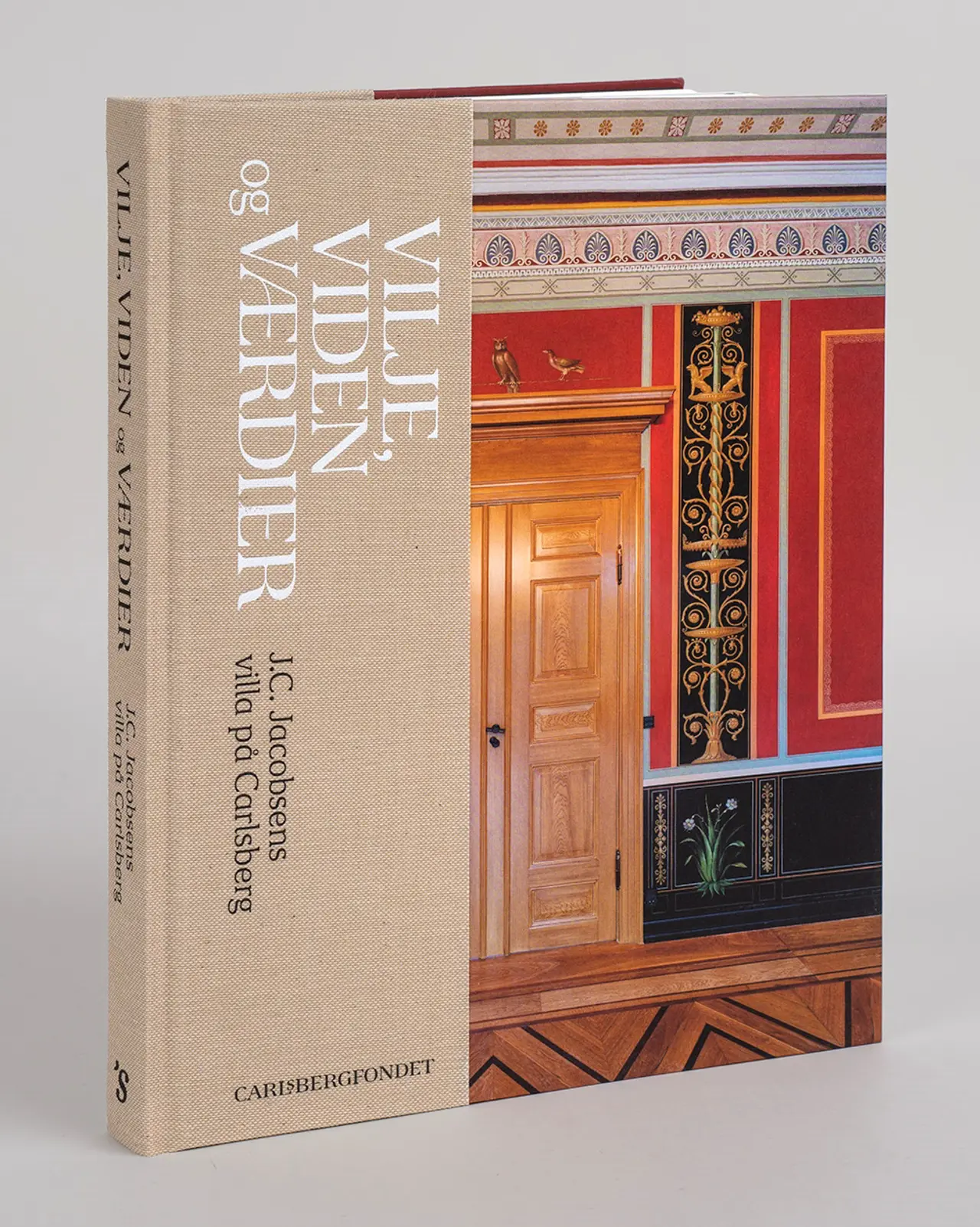
Historic restoration of brewer J.C. Jacobsen’s villa celebrated with new book
Published:
26.01.2022
The Carlsberg Foundation is kicking off 2022 by opening the doors to the newly restored Carlsberg Academy. The restoration has been carried out by some of Denmark’s most highly skilled architects, conservators and craftspeople, who have carefully returned brewer J.C. Jacobsen’s private villa to how it looked when it was built in the mid-1800s. To mark the restoration, the Carlsberg Foundation and Strandberg Publishing are bringing out a book with the title ‘Will, Works and Values – J.C. Jacobsen’s villa at Carlsberg’.
Since August 2019, J.C. Jacobsen’s magnificent villa on the Carlsberg site at Valby in Copenhagen has been undergoing extensive restoration and refurbishment. The ambition has been to return the villa, which since 1997 has served as a scientific conference centre under the name of the Carlsberg Academy, to how it originally looked.
From floor to ceiling, inside and out, the villa, conservatory and garden now once again look like they did when they were home to J.C. and Laura Jacobsen – thanks to the painstaking and careful work of a number of Denmark’s most highly skilled architects, braziers, smiths, conservators and plasterers, not to mention engineers, electricians and carpenters. At the same time, the villa has acquired new pieces of art, including 16 new pots for the Winter Garden made by landscape architect Kristine Jensen and decorated by artist Cathrine Raben Davidsen with funding from the New Carlsberg Foundation.
“It’s a great pleasure for me to be able to kick off 2022 by opening up the doors to a fully restored and refurbished Carlsberg Academy,” says Professor Majken Schultz, Chair of the Carlsberg Foundation. “It’s been an extremely impressive effort to restore J.C. and Laura Jacobsen’s private villa to its historic starting point while respecting modern aesthetics and functional requirements. After more than two years of renovation work, I look forward to the Carlsberg Academy once again holding scientific meetings, research conferences and cultural events. It’s my hope that visitors will be able to grasp the international vision behind the building’s construction. And that they will appreciate the care and meticulousness with which the building has been technically upgraded and the interior returned to how J.C. and Laura Jacobsen originally conceived it.”

36 specialist trades involved
During the extensive restoration work, it turned out that virtually everything could be recreated. Although some of the interiors from the time of the brewer have been lost, the restoration architects had sufficient sources and evidence to get an overview of the original style. J.C. Jacobsen’s private study, for example, has been refurnished with the original furniture.
A total of 36 specialist trades have been involved in the work of re-establishing the villa and the atmosphere of the brewing family’s time. The work has included repainting wall decorations, friezes and stucco ceilings. Furthermore, the original oak doors, which had been painted white during a renovation in 1995-1997, were recreated using so-called graining, a painting technique that imitates woodwork.
Section of the barrel-vaulted ceiling in the dining room after the most recent restoration in 2021. Photo: Anders Sune Berg
The experience of Carlsberg Academy will in the future be even more captivating as a result of the interior's precision and details being brought closer to the original expression. Photo: Karina Tengberg
Repainting the decorative details is a major undertaking requiring great skill and effort, but the visual impact is great and absolutely crucial for the restoration of the room's original decoration. Photo: Karina Tengberg
The Doric columns of Pompeii's greenhouse, made of limestone from Faxe, were well protected during the restoration. Among other things, the greenhouse's roof structure was cleaned, and approximately 2100 panes of glass were carefully removed after being numbered. Photo: Karina Tengberg
The renovation was led by Elgaard Architecture, a specialist in cultural heritage and historic buildings. In collaboration with historians and conservators, the firm identified and mapped the villa’s special features and characteristics, which have guided the entire restoration.
“It’s been highly instructive to recreate rooms that were built and decorated to such a high quality,” says architect Peder Elgaard. “J.C Jacobsen created a home that represented his own lifelong educational journey. Today, the building still has a lot to teach us about spiritual, artistic and craft values.”
Although the Carlsberg Academy has been restored out of a desire to conserve the building’s all-important values, the ambition has not been to achieve a mummified preservation of the past. Rather, the vision has been to rehabilitate and conserve the building on a scientific and artistic footing to make it once again contemporary and relevant today.
“Most of what visitors will see in the building today is a precise reconstruction of the rooms as they looked in the time of the Brewer,” says Peder Elgaard. “But the building has also been upgraded to the highest modern standards for technical installations, which will help create a good indoor environment and reduce energy consumption. We’ve very carefully balanced reconstruction, interpretation and new additions to the historic building such that the interplay between the whole and the smallest detail enhances the building’s historical authenticity.”
Restoration celebrated with a new book
To mark the restoration and reopening of the Carlsberg Academy, the Carlsberg Foundation and Strandberg Publishing are bringing out the richly illustrated book 'Will, Works and Values – J.C. Jacobsen's Villa at Carlsberg' (Danish title: 'Vilje, viden og værdier – J.C. Jacobsens villa på Carlsberg').
In six well-written chapters, the book presents the villa in its historical and modern contexts – and at the same time reveals life in and around the brewing family. Historian Birgitte Possing, dr.phil., is the author of the main chapter, which gives an account of J.C. and Laura Jacobsen and the values on which they built the Carlsberg brewery. Architectural historian Peter Thule Kristensen traces the villa’s architectural-historical roots and shows how it was shaped by the Danish Golden Age of the first half of the nineteenth century and the formal idiom of Classical Antiquity but was also more complex than first assumed.
Video
Laura Jacobsen was more important to Carlsberg than history books give her credit for

In the remaining chapters, landscape architect Kristine Jensen writes about the restoration of the garden back in 2017; art historian Birgitte Anderberg about the artistic legacy of the Brewer, as now manifest in the decoration of the villa; science historian Kristian Hvidtfelt Nielsen about the villa’s 80 years serving as an important meeting place for scientists, artists, business associates and politicians; and cultural heritage expert Christoffer Thorborg about the now completed restoration of the villa with respect to the history of restoration art and the challenges associated with building restoration in general.
“I’m extremely proud that, together with Strandberg Publishing, we’re also able to present the book 'Will, Works and Values – J.C. Jacobsen's Villa at Carlsberg',” says Majken Schultz. “The book, which has been arranged and prepared under the publishing firm’s expert editorship and guidance, intricately merges the brewing family’s history and the villa’s concepts and usage with the now completed renovation. The book’s authors deserve huge gratitude for their contributions, all of which bear the stamp of high academic quality. It was important for the Carlsberg Foundation to give the editors and authors free rein to identify those aspects of the building, renovation and brewing family’s history that they considered most relevant and interesting. Among other things, it’s extremely interesting how Birgitte Possing, in the book’s main chapter, has included the roles of women in the Carlsberg family’s history.”
Background: about brewer J.C. Jacobsen’s villa and the Carlsberg Academy
In 1846, J.C. Jacobsen established the Carlsberg brewery on a large and well-situated plot of land on Valby Hill. In the years that followed, as part of the brewery site he commissioned the building of a private villa with a conservatory and garden where he could live with his wife Laura and son Carl.
Here they together established a cultural power centre where their lives and work merged.
After J.C. and Laura Jacobsen had passed away, the villa served throughout most of the 1900s as an honorary residence for a series of eminent scientists, including Niels Bohr. In 1997, the villa was converted into a scientific conference centre and christened the Carlsberg Academy.
The Carlsberg Academy is today owned by the Carlsberg Foundation.
Newsletter
Are you a researcher and interested in news related to our calls and grants? Or do you want to keep up with news about the foundation’s activities? Then sign up for one of our newsletters here.



